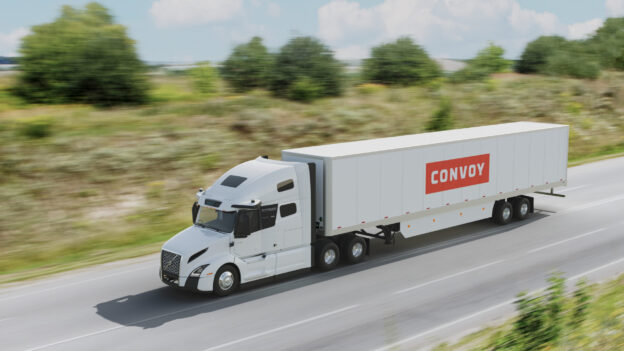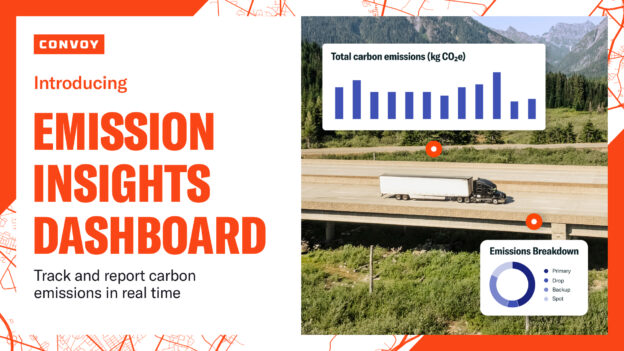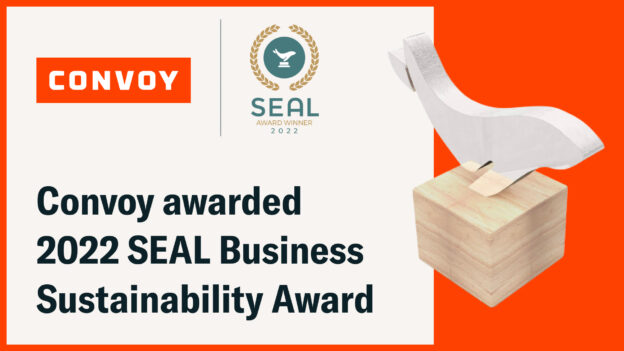Is It Better For The Environment To Shop Online Or In Person?
Sustainability • Published on June 10, 2020
With all of those trucks heading out into suburbia to deliver your latest gadget, fashion find, or book, is online shopping terrible for the environment? Online shopping makes up one in seven retail purchases worldwide and the question then becomes, what is its impact on the environment? Online retailers insist their shipping is the greener delivery choice — much better than consumers driving to the store individually. So who is right? And are there even better options? Ultimately, the answer really matters for the future of our climate.
Dr. Anne Goodchild, Director of Supply Chain Transportation & Logistics Center at the University of Washington, joins the conversation in Convoy’s The Business of Carbon Emissions video series.
Anne helps us navigate the in-person versus online shopping debate by sharing the benefit of her extensive research into these important questions:
- What’s the relationship between transportation and the environment?
- Why do issues of route optimization and shipping inefficiencies persist?
- What is better for the environment: shopping online or in person?
- What’s the one thing consumers should know when deciding whether or not to shop online?
By highlighting the key factors which have an impact on our shopping experience — including local consumption, speed of demand/order delivery, and energy intensity to secure that product — Anne helps us all make a more informed shopping decision.
Watch the video here for read the transcription below.
Convoy provides shippers reliable, flexible, and instant capacity when they need it most. Learn more about shipping with Convoy today.
TRANSCRIPTION
Jennifer Wong: Hi everybody. My name is Jennifer. I lead sustainability at Convoy and today we’re going to be diving into the world of shopping. We’re going to be learning about the question of what produces more emissions, shopping online and having something delivered directly to you or going to the store yourself and there’s questions on both sides. Whether all of those trucks heading out into suburbia to deliver your latest gadget, fashion find, or book is more efficient than you hopping in a car and going to a store yourself. So today we have Dr. Anne Goodchild here to help us answer the question with the research that she’s done for the last couple of decades. Dr. Anne Goodchild leads the University of Washington’s academic and research efforts around supply chain, logistics, and freight transportation. She’s also professor of civil and environmental engineering and serves as the founding director of both, the supply chain, transportation, and logistics online master’s program and supply chain transportation and logistic center. Welcome Anne!
Anne Goodchild: Thank you. I’m glad to be here.
Jennifer: Yes, well thank you for sharing all of your research in our quick segment today. Just bringing more awareness into carbon emissions and shopping. Something people think about day to day. I guess first, could you describe a little bit more around the alignment between transportation and the environment?
Anne: Yeah, because that was one of the questions that I had when I started looking into, you know, how do you reduce carbon emissions from truck routing, essentially, and I think, like many people, my impression was that that was going to be costly. That you were kind of going to have to pay more money to reduce CO2 and there was going to be a trade off there. But what we have found [2:00] is that overwhelmingly, cost efficiency and CO2 efficiency are really aligned. And especially when you look at operating fleets. So like, you can dream up some examples, kind of theoretical examples where that’s not the case, where somebody’s operating so close to perfection that there’s no more room but when we looked at real fleets and data from real operations, in every case actually that we found, we saw there were ample ways to both, reduce cost and reduce CO2 emissions.
Jennifer: So why do you think that the problem of route optimizations and the efficiencies that exist today just haven’t been solved yet. Do you think that there’s reasons for that?
Anne: Absolutely, I think carriers and operators are very motivated to reduce cost. I mean, and they’re so good at it but they’re operating within the constraints of their own customers and so…I mean, the cheapest way to run a truck is to not run it at all. Right? It cost money to move anything. So, the goal of the carrier is to, you know, A, get the job done, and then, B, do that with the least expense. And so, it’s what they’re being asked to do that’s those constraints. And often, given the timing and the location and the load itself, it’s impossible or it’s not practical to find that, you know, to do it cheaper. You know, they’re going to lose that customer if they don’t get there today. Or, you know, they’re paying a lease on a truck and they have to pay that monthly fee and so they’re willing to take a job that, you know, has an empty backhaul just because they’re getting some revenue. So, [4:00] it’s not that the industry isn’t aware of how to do better, its that they’re in a marketplace with constraints that require, you know, that they add cost or that they have some empty miles, or at least given the way the industry is currently organized and currently operates.
Jennifer: Sure. So, with the fragmentation, there’s just a lot of opportunity for lots of miles to be reduced, essentially.
Anne: Yeah. You know, I think we all have to take responsibility for the demands that we make of the freight system, and so, you know, if you looked directly at, like, online shopping. If I say, “Well, I must have my rubber boots at my house within 2 hours,” it’s practically impossible for someone to create an efficient, you know, and full route given that request, they’re probably going to send a vehicle directly to my house and then deadhead. But that’s what I’m demanding as a consumer, or as a customer of the transport system.
Jennifer: Let’s dive into that topic. What is better for the environment? Online shop or to go to the store yourself?
Anne: Yeah, so the best thing for the environment is to not buy whatever you’re buying in the first place. But given that you’re buying something, you know, we want to do that with sort of the least energy intensity. And so, there isn’t a simple answer to the question of which is better because it all depends on how it’s implemented. What you bought, how you would have gotten to the store and so we can take about sort of typical averages but there’s, you know, there’s no answer that says in all cases, [6:00] given whatever you bought and however fast you asked for it, you know, online shopping is better. You know, that’s not true. So, there’s cases where, I think, either, you know, one, online shopping is better and they’re cases where going to the store is better, so I think that the interesting thing is trying to unpack that. Now, it gets a little bit complicated and I think there’s still a few basic principles that people can rely on. So, one of those is that the farther away this thing is from you that you request, the more energy it takes to move it to your house. So, you know, local consumption is still more energy efficient. So if it was sourced, you know, domestically or in your own region, then it just takes less energy to get it to you than if something is sourced, you know, halfway around the world and you can’t beat that. Also, speed. So, the more quickly you demand it gets to you, the more direct and dedicated the shipment a carrier needs to provide. Whereas if you say, you know, you buy something now and you’re like, “Get it to me when it’s convenient for you,” they can pop it into an extra load where there’s, you know, a little space left or they can wait until next week when a shipment is going out anyway. So, you know, the closer you can source it is still better. Whether you’re online or you’re at the store. And the slower that you can sort of demand it, the more the supply chain and transport logistics professionals have an ability to design, you know, the most efficient system they can to get it to you. Whereas if you’re asking for something immediately, you know, it’s probably coming in a dedicated vehicle, you know, as fast as possible. That’s going to be really energy intensive. So, online shopping can be great in that a delivery service is really motivated to fill up a truck and, you know, to get it to you as sort of a least [8:00] per package cost that they can. That’s how they make money. And there’s a lot of potential in online shopping for energy reductions. But, you know, that doesn’t apply all the time. So, if you think about, like, buying a pizza online. They come directly to your house as quickly as they can. That’s not more efficient. But if I’m getting something from a traditional package carrier who comes to my neighborhood everyday anyways, you know, the incremental cost of that package is pretty small.
Jennifer: As I start to think about how I can make more environmentally positive choices when I do have to buy something online, what would be the one take away or thing consumers should really remember when they’re making these decisions shopping day to day.
Anne: Well, I think that consumers could really benefit from some better information. It’s very hard as a consumer to know. Well we don’t know when we buy something online how it’s getting to us. We don’t know if it’s being flown in a plane or if it’s, you know, where it’s being sourced from either. So, I think that puts probably too much weight on the consumer and how much time do we have every time we buy something to really try to understand exactly how it’s moving? I mean, people don’t have that kind of energy to put into every purchase decision. So, I try to stick with those principles of sort of slow and local and those will always be good principles. It’s never a bad thing to make those choices in terms of energy efficiency. And I think that individually the other thing is like, if you are going to the store, can you, you know, do multiple things on a trip and can you, [10:00] you know avoid car trips. Because the alternative to a delivery service is typically somebody driving somewhere which is not usually very efficient either. You know, we drive fairly large vehicles and the average basket size if very small and the average consumer, you know, is just driving to the store and back and so that’s a pretty inefficient delivery model.
Jennifer: Thank you Anne so much for joining us today.
Anne: Yeah, it was fun. Thanks for the invitation.



